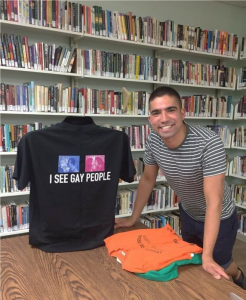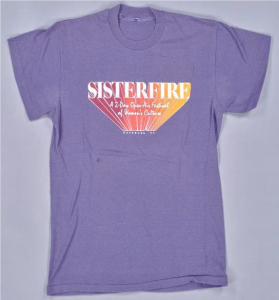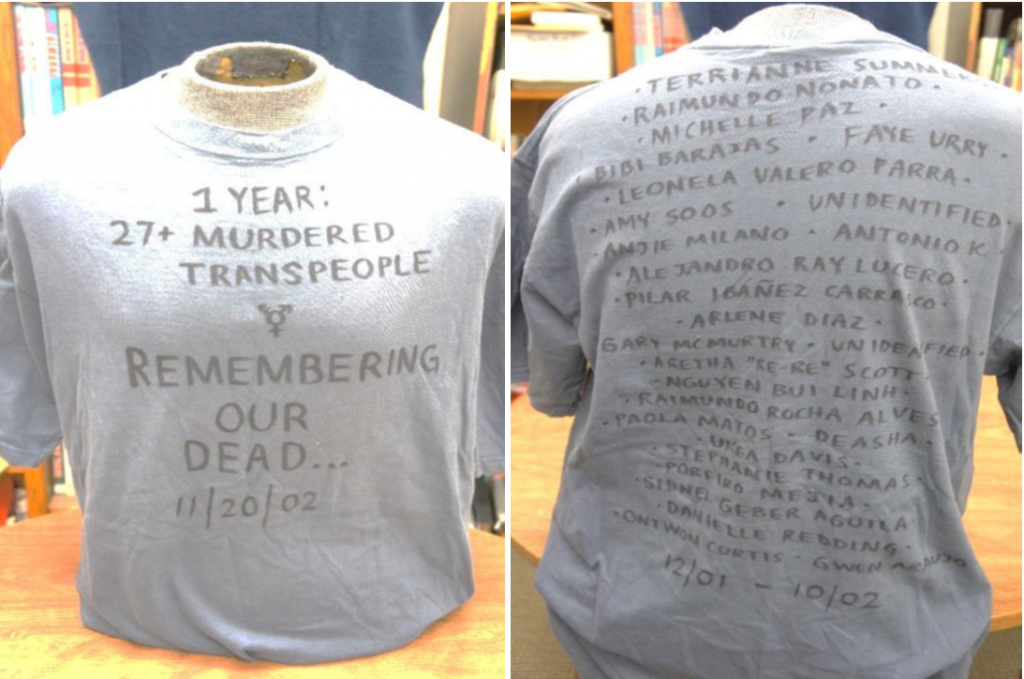An Interview with Eric Nolan Gonzaba by Briana Pocratsky
On September 12, 2016, The Sociologist interviewed Eric Nolan Gonzaba about Wearing Gay History, an online archive that explores lesbian, gay, bisexual, and transgender identities though material culture. Eric Nolan Gonzaba, Founder and Director of Wearing Gay History, is currently a doctoral student in American history at George Mason University studying 1970s-1980s lesbian, gay, bisexual, transgender (LGBT) nightlife in the Mid-Atlantic. Gonzaba is a member of the Board of Directors of the Rainbow History Project, which aims to collect and preserve LGBT history in the Washington, DC area. He is a contributor to OutHistory, a blog that aims to explore LGBT history.
The Wearing Gay History website includes material culture from the past 40 years gathered from archives across the United States. The project uses an everyday item, the t-shirt, to uncover and make available often unknown narratives regarding LGBT history.
According to Gonzaba, each t-shirt tells a story in relationship to specific historical and social locations: “By looking at these diverse shirts, the collections often don’t necessarily deal with the communities that they were a part of and so one of my arguments is how interconnected LGBT communities are during the time they were wearing these t-shirts. From the late ‘60s and the early ‘70s to the present day, you have a communication, if not migration of people, across geographic lines. I think the shirts prove that by having them at different archives and owned by different people at different times, (like going to a Gay Pride March in New York City or going to the March on Washington), people are exchanging ideas and shirts and comingling in a way, and I think the shirts show that.”
Gonzaba explains that Wearing Gay History originally began in 2014 as a small project for a graduate class at George Mason University. For the project, Gonzaba digitized the entire LGBT t-shirt collection in the Chris Gonzalez Library and Archives in Indianapolis, Indiana. From there, Gonzaba continued adding collections from different archives across the country to the online archive, and Wearing Gay History grew into a larger project. To archive the images and make them available to the public, Gonzaba uses Omeka, an open source archival web platform created at George Mason University’s Roy Rosenzweig Center for History and New Media.
Goals of Wearing Gay History
One objective of Wearing Gay History is to challenge the “bicoastal bias” of queer history. Gonzaba elaborates on the bicoastal bias of queer history and how Wearing Gay History addresses this concern: “One of the goals of Wearing Gay History is to uncover LGBT histories, and one of the ways we can do that is to look for sources that are nontraditional. One of the nontraditional sources that I’m most interested in is the idea of material clothing, particularly the t-shirt, which can uncover histories of queer people who aren’t necessarily in San Francisco or New York and combat bicoastal bias of queer history.”

Eric Nolan Gonzaba at the Gerber/Hart Library and
Archives of Chicago, Illinois. Source: Wearing Gay History.
Wearing Gay History includes material culture not just from these two cities often associated with American LGBT culture but also from Philadelphia, Chicago, Indianapolis, Minneapolis, and San Antonio. Gonzaba continues to add items from cities across the United States and the world. The project is also designed to uncover the often ignored history of diverse LGBT culture. Gonzaba emphasizes the diversity of LGBT culture, which, he says, is often reduced to an oversimplified conception.
Gonzaba believes that through the digitization of the t-shirts, the diversity of the LGBT community became readily apparent: “Wearing Gay History has taught me about the diversity of queer communities. And you’ll have things like pride shirts, leather shirts, lesbian t-shirts, drag queen and drag king shirts. There are different events, and they deal with topics that are overtly political, like anti-violence projects. But, some t-shirts have nothing to do with politics, like simply a pun. The idea is that these shirts carry diverse meanings to different people. That idea has led me to think about this social movement as diverse and not monolithic.”
Washington, DC and LGBT Culture
Gonzaba notes that many of the t-shirts found in Washington, DC archives or associated with the District tend to be direct and simple: “What’s fascinating to me is that the DC t-shirts will often say something like ‘Gay Pride ’71,’ and it’s just a very simple shirt. But they have the word ‘gay’ and often a lot of shirts don’t have that. The ‘DC Gay Switchboard’ is one of my favorites. It’s a simple shirt with the lambda symbol, which was a symbol of gay politics. The shirt says ‘DC Gay Switchboard’ and has a phone number on it. It is often called a support line, which it was to an extent. But, it was a switchboard that was meant for visitors in town to call and ask for the hours or directions to gay bars. The switchboard became this lifeline in a place when you didn’t have Google. It became a way to connect to a community in a place that you weren’t familiar with or talk about things if you needed support. It was completely volunteer run.”
Gonzaba also adds that many t-shirts that reference Washington, DC are actually found in archives outside of the area.
“The interesting thing about the items involving DC in the collection is that the items aren’t necessarily from the DC archives but from other archives across the United States. They usually involve DC trips, like March on Washington. I say that because one of my favorite shirts is DC-related but not necessarily from DC. My goal was to try to get a shirt from every state, and I have almost all of them. My first Alaska shirt, which is from the 1979 March on Washington, was their delegation shirt for the March. It simply says ‘National March on Washington for Lesbian & Gay Rights.’ Besides the shirt saying ‘Lesbian & Gay Rights,’ there is a penguin on the shirt. Unless you read the shirt, you wouldn’t have any idea it’s connected to gay history or politics. That’s something I like; the simplicity of it and yet it means a lot. You can tell a group from Alaska came all the way to DC for that event.”

Sisterfire 1984. Source: Wearing Gay History, University
of Southern Maine Special Collections, Portland, Maine.
In addition to digitizing material culture from archives and adding them to the online collections, Gonzaba creates exhibits about specific t-shirts as a way to provide context and highlight the t-shirt’s significance. One exhibit on the website, titled “A Lesbian Capital: Odd Girls in Washington DC,” explores lesbian activism, which is largely omitted from American queer history. Gonzaba explains how the exhibit attempts to address this omission: “I created the exhibit because of a recent concern among lesbian activists in DC, especially among social circles on Facebook and Twitter, about the erasure of lesbian spaces in Washington, like the closing of the oldest lesbian bar in all of Washington and all of the country actually. And I wanted a means for these lesbian activists to see their history and possibly explore, negotiate, and engage with it in different ways.” One section of the exhibit, called “Sisterfire,” shows how the DC area specifically played a vital role in the emergence of women and lesbian musicians in the mid-1970s.
Remembering Our Dead
Of the thousands of t-shirts that Gonzaba has digitized for Wearing Gay History, there is one in particular that stands out to him: “The one I always come back to is the first transgender shirt that I ever digitized. It was in the Indianapolis archives, and it was a very serious topic, which is violence against trans people. It’s called ‘Remembering Our Dead,’ and what I like about it is even though it’s relatively recent history, (it’s from 2002), it’s completely handmade so it is written by somebody. They list 27 people who have been murdered because of their transgender identity including a couple Hoosiers, people from Indiana. It brings me back to how these shirts can be overtly political, they can deal with issues that are overlooked, and they can be handmade, which I think is amazing. What is great about this is that this shirt meant so much to somebody that they spent a good deal of time writing out very neatly names on it. So, I think it’s a very powerful shirt.”

Remembering Our Dead. Source: Wearing Gay History,
Chris Gonzalez Library and Archives, Indianapolis, Indiana.
The Future of Wearing Gay History
Currently, Wearing Gay History includes 3,352 clothing materials, most of which are t-shirts, from 16 archives across the United States in addition to Canada and South Africa.
Although occupied with dissertation writing, Gonzaba plans to continue working on Wearing Gay History as there are already another 1000 items waiting to be posted on the site.
When asked about his goal for the future, Gonzaba emphasizes the importance of connecting his research to more publics: “My dream is for Wearing Gay History to be connected to different platforms through different means so that it is more accessible to people and not just the researcher. I think if there is a Wearing Gay History 2.0, it’s to make it more accessible by figuring out ways to target even more audiences to get people to use it more, whether that’s through creating interactive timelines or games or focusing on social media aspects. I still am trying to figure out the best way to reach a wider public because the goal of the website is education.”
To learn more about Wearing Gay History and to explore the collections and exhibits, visit http://www.wearinggayhistory.com/
Return to September 2016 Issue
